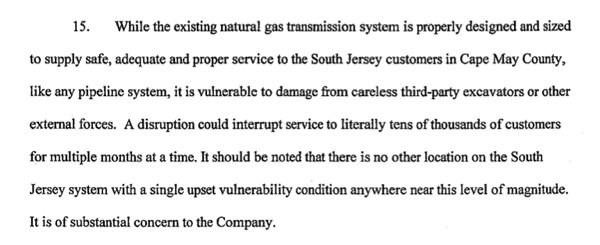Saving the Pinelands Plan, While Fracking the Forest, Acidifying the Ocean, and Cooking the Planet
Pinelands Commission Ignores Climate Change Threats
NY’s Adirondack Park Plan Considers Energy & Climate Change
Are We Going From the Pipeline MOA Frying Pan to the Fracking BL England Fire?
The failure to address energy policy, climate change, and regional issues that impact Pinelands ecosystems are HUGE gaps in the Pinelands Comprehensive Management Plan (CMP) that must be addressed immediately. ~~~ Bill Wolfe
The Pinelands Commission did the right thing in rejecting the proposed South Jersey Gas Co. pipeline Memorandum of Agreement (MOA). That MOA would have set a horrible precedent and undermined the integrity of the Comprehensive Management Plan (CMP) and the Commission itself.
But, in doing so, while preserving the integrity of the CMP, the Commission ignored the most significant threat to Pinelands forests and ecosystems: climate change.
As we’ve noted, Pines forests are already being severely impacted by climate change as a result of the southern pine beetle.
But threats come not just from the pine beetle: climate change is altering rainfall patterns (inundation/drought) and the timing of seasons, wreaking havoc with the hydrology of the Pinelands and the water sensitive wetland, pond, and forest ecosystems that are adapted to current conditions.
Pinelands scientists have already demonstrated how sensitive Pines ecology is to water in a series of research projects designed to assess the hydrological and ecological impacts associated with withdrawal of water from pinelands aquifers (see: Kirkwood-Cohansey Project)
But pumping groundwater is just one way to modify Pinelands hydrology – rainfall patterns can have equivalent or far greater impacts: climate models suggest new cycles of heavy sporadic rainfall leading to inundation, followed by extended periods of drought.
Shockingly, all these impacts and risks – already documented in the scientific literature – were ignored by the Pinelands Commission in their review of the SJG project, a project that DEP was forced to concede would generate at least 2.5 million tons of CO2 emissions per year (exclusive of lifecycle methane emissions from fracking and distribution of the gas to the BL England plant).
Here was the totality of the Commission’s consideration of climate change impacts and risk, from the staff Report – note how they narrow the scope of review to the pipeline (not BL England and fracking) and deny current impacts and future threats:
Comments were submitted focused on the need for the Commission to address the broad issue of climate change with regard to this project. Comment suggested that the Commission consider the impacts of the project on the Pineland‟s greenhouse gas footprint. The Commission did investigate the potential for increases in fugitive methane emissions as part of this project and found that such emissions are associated with older pipelines and ancillary infrastructure. Newer construction materials are not prone to leaks. The NJDEP provided detail, noting that greenhouse gas emissions from natural gas transmission and distribution amount to 2.2% of total statewide emissions, thus NJDEP considers emissions from this sector small relative to total statewide releases. The NJDEP “considers this new pipeline to have a minimal impact on the state‟s GHG emissions”. Commenters raised concerns about climate change impacts associated with the production of natural gas. The CMP does not contain any standards for regulating environmental impacts associated with the production of natural gas outside of the Pinelands area.
Worse, Chairman Lohbauer prefaced his vote by stating the fracking was of no concern to the Pinelands Commission.
Let me put the Pinelands Commission’s denial in perspective.
Could anyone imagine the Chairman of the Adirondack Park Agency – who oversees 6 million acres of forested lands that have been devastated by acid rain – – saying the midwestern coal power plants were of no concern because they are located outside the Park?
The Adirondack Park Agency (APA) has an energy policy that is expressly designed to:
integrate concerns for energy supply, conservation, and efficiency into Park planning, public education, and project review functions.
The policy is intended to protect Adirondack park resources while recognizing that energy conservation and efficiency is critical to viable sustainable communities within the Park and within a global context. Wise use of energy resources and development of alternative energy resources offers an opportunity at a local level to contribute to the reduction of global atmospheric carbon levels.
Let’s repeat that APA policy:
development of alternative energy resources offers an opportunity at a local level to contribute to the reduction of global atmospheric carbon levels.
In contrast with the APA, the Pinelands Commission has no policy – despite the fact that NJ’s Global Warming Response Act requires an 80% reduction in current GHG emissions. The lack of policy creates a huge void, as we saw in the SJG pipeline debate, that allows special energy interests to elevate their concerns over Pinelands ecology.
And here’s how the APA considers climate change in their forest protection planning and regulation: (Source EIS)
Within the Adirondacks are areas referred to as ―matrix blocks, or intact forests. These blocks are significant due to their diverse underlying abiotic factors (elevation, land form and geology), the overall condition of the forest, and by being less fragmented by roads.
Matrix blocks are important for habitat and species resilience. Resilience concerns the ability of a living system to adjust to climate change, to moderate potential damages, to take advantage of opportunities, or to cope with consequences; in short, its capacity to adapt. The Essex Chain Lakes, Indian River, OK Slip Falls and OSC Tracts add to these matrix blocks and enhance the resiliency of the Park’s Temperate Deciduous Forest.
Could you imagine a freshwater fisheries scientist from a northeastern state – whose fisheries are poisoned by mercury – saying that midwestern coal plants are of no concern?
Take a look at how the state of Massachusetts manages the mercury issue – note that the scope of their concern is regional and not limited to the land area of Massachusetts.
In contrast, the Pinelands Commission has no policy to address impacts from pollution sources located outside the boundaries of the Pinelands that impact pines ecology. And the scope of their review of a project fails to consider lifecycle emissions and secondary impacts.
The failure to address energy policy, climate change, and regional issues that impact the Pinelands are HUGE gaps in the Pinelands Comprehensive Management Plan (CMP) that must be addressed immediately.
Otherwise, we go from the pipeline MOA frying pan to the fracking BL England fire.




